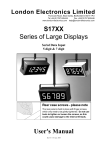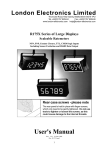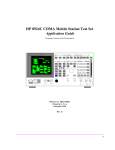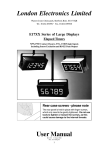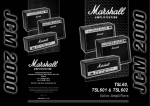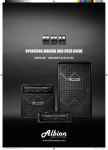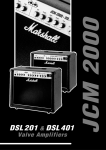Download User`s Manual - London Electronics Ltd.
Transcript
London Electronics Limited Thorncote Road, Near Sandy, Bedfordshire SG19 1PU Tel +44(0)1767 626444 Fax +44(0)1767 626446 www.london-electronics.com [email protected] P175X Series of Large Displays Process Input 4-20mA, 0-10V, 0-20mA, 1-5V Including Sensor Excitation and RS485 Data Output Rear case screws - please note The rear panel is held in place with finger-screws, which only need to be gently tightened. Do not use tools to tighten or loosen the screws, as this could cause damage to the internal threads. User's Manual Rev.3.0 30 June 2008 Doc. P17_lon.p65 1 NOTES 2 CONTENTS. SECTION INTRODUCTION.................................................................................................. PAGE 4 UNPACKING AND INSPECTION.......................................................... 5 2.0 GENERAL INFORMATION................................................................... 2.1 General specifications.................................................................................. 5 6 3.0 INTERNAL CABLES............................................................................... 3.1 Signal cables................................................................................................ 3.2 Power cables.................................................................................................. 7 7 7 DETAILED OPERATING INFORMATION 4.0 Analogue I/P Selection..................................................................................... 4.1 Jumper Functions and Positions....................................................................... 4.2 Analogue Input connections............................................................................ 4.3 RS485 (option) output notes........................................................................... 4.4 Contact Closure Remote Programmer connections...................................... 4.5 Programming your display............................................................................. 4.6 The Programming Menu ............................................................................. 4.7 Programming Flow Chart............................................................................ 4.8 The Configuration Number and what it does................................................ 4.9 1st Config. Number Digit ... Behavior................................................................ 4.10 2nd & 3rd Config. Number Digit ... Filtering................................................... 4.11 4th Config. Number Digit ... Data O/P Baud Rate......................................... 4.12 5th Config. Number Digit ... Response Number............................................ 4.13 6th 'INVISIBLE' Config. Number Digit ... Brightness setting........................ 8 8 9 9 10 10 11 12 13 13 13 13 14 14 1.0 5.0 5.1 5.2 5.3 5.4 5.5 INSTALLATION....................................................................................... Mounting positions...................................................................................... Panel mounting............................................................................................ Wall mounting............................................................................................. Suspension mounting................................................................................... Multiple display mounting............................................................................... 14 15 15 15 15 16 6.0 TROUBLE SHOOTING AND MAINTENANCE, Error messages........ 16 7.0 SAFETY CONSIDERATIONS.. N 16 8.0 WARRANTY.................................................................................................. ....................................................... 3 17 THE PROCESS INPUT MODEL - P175X INTRODUCTION This model is intended for large measurement display use. It accepts the most commonly encountered process signals of 0-10mA, 0-20mA, 4-20ma, 1-5VDC and 0-10VDC, and is fully scaleable to read in engineering units. Scaling can be carried out remotely, whilst the display is in-situ, and because no potentiometers are used, the display stability is superb. An excitation supply is available to power 2 wire transmitters, or to boost loop drive if required. The decimal point can be placed as required, and the least significant digit can be made to count in units, 2's, 5's or 10's. The right hand digit can be blanked, effectively 'centralising' the display if less than 5 digit resolution is required. If specifically ordered , we can supply the displays with a silk screened legend identifying the measurement being displayed, for example, Kg., Deg. C. etc.. An optional RS485 output is provided, useful for feeding remote mimic displays. The configuration settings and calibration constants of the display are stored in non-volatile E2PROM memory, which is retained for at least 10 years. Change to the settings is achieved by way of remote contact closure inputs, allowing alteration of the unit’s configuration menu, calibration and brightness. The case is sealed to IP65/NEMA4, and the lens is 4mm thick polycarbonate, making it ideal for use in food industry washdown applications. 4 1.0 UNPACKING AND INSPECTION PLEASE check the carton’s contents as soon as possible after receipt, to detect any transit damage or losses.Unpack the contents and check each item in the box against the check list below to make sure you have all items. Check List : Handbook Display Mounting kit ( where appropriate ) Programming Unit ( If Ordered ) In the event of damage, please contact the carrier and advise our sales office of the fault. Please retain the carton packing material, for future possible use. 2.0 GENERAL INFORMATION This display is part of a family of units for broadcasting process values and data on easy to read large 7 segment displays. Character heights of 2", 4" or 6" are standard, and, dependent on type, displays are 5 or 7 digit. Extra-large and Daylight viewing displays are available to special order. The enclosures for the displays are of welded UPVC material with tough lenses, providing certified protection to NEMA4 for the internal electronics. Case colors are white or black. The units incorporate a 95 to 265VAC power supply ( Which can be used on DC in the range 100 to 300 VDC ) for operation off any power source without the need to re-configure. Display brightness is settable to 4 levels to accommodate differing ambient light conditions and the 3 standard character heights provide a choice of viewing distances of up to 20, 40 and 60 metres. Other character heights and brightnesses are available to special order. The large displays are based around a common power and control card which is linked to display units of different sizes. Instrument behaviour is set by way of remote contact closure pushbuttons, which provide access to and alteration of the instrument’s menu, and the settings are stored in 10 year non-volatile memory. 5 2.1 GENERAL SPECIFICATIONS Display type Analogue input display intended for large remote display use. Signal inputs 0-10mA, 0-20mA, 4-20mA, 1-5V, 0-10V Can accept RTD or T/C types to special order Can be factory scaled to accept non-standard ranges Input Resistances: Current I/P's = 45 Ohms, Voltage = 1 Megohms Excitation Supply: Nominally 13VDC at 60mA max. Accuracy: 0.02% of range, Tempco = 50ppm/Deg.C Scaling Zero & Span fully scaleable remotely. Decimal point position selectable Inverse scaling available eg 4-20mA = 100 to 0 Signal Output (optional) RS485 at 300, 1200, 2400 or 9600 Baud Data format Serial ASCII at 300,1200,2400 or 9600 baud; 1 start bit, 8data ( or 7 data plus parity ) and 1 or more stop bits. Handshake No handshake, unit always transmits data Case material: UPVC, White or Black Case size:(mm WxH) 5 digit 7 digit 2" 288x120 384x120 4" 480x168 672x168 6" 624x192 864x192 Case depth Weight : : Display type: 2" digit height 4" digit height 6" digit height 90mm ( 115 mm including rear cable/glands) 5 digit 2" 2.5Kg 4" 4.5Kg 6" 5.0Kg 7 digit 3Kg 5Kg 6Kg High efficiency red LED 57mm high 7 segment display tiles Ultrabright red LED 102mm high 7 segment display tiles 144mm high characters formed from twinned individual 5mm round red LEDs Daylight viewing versions, whether 2", 4" or 6" are made up of individual 5mm round lensed LED's Power supply : Power consumption : 95-264VAC, 100 to 300 VDC, Via Rectifier, non-specific polarity 20W typ. 6 3.0 INTERNAL CABLES The units are supplied with approximately 2 metres of free ended cable for power, signal and serial ports. You may connect your own cable to this, via a junction box, or completely remove the supplied cable and install your own. REMEMBER The signals you will be feeding to the displays are quite small in comparison to some of the undesirable ‘noise’ generated by certain types of common electrical equipment. To obtain the highest degree of accuracy and reliability from your indication equipment, we strongly suggest that you.... DO NOT run signal cables adjacent to power/switching lines or near equipment liable to generate large amounts of electrical noise, such as contactors, solenoids, fluorescent tubes, discharge lamps, motor control equipment, etc. Do use shielded, twisted-pair extension cable to minimise the amount of noise being fed into the display. WARNING: RISK OF LETHAL ELECTRICAL SHOCK N YOU MAY NEED TO OPEN THE CASE TO ALTER JUMPER POSITIONS OR TO PANEL MOUNT THE DISPLAY. BEFORE COMMENCING TO OPEN THE CASE YOU MUST ENSURE THAT POWER HAS BEEN DISCONNECTED, AND MUST ENSURE THAT POWER CAN IN NO CIRCUMSTANCES BE RE-APPLIED TO THE DEVICE WHILST THE CASE IS OPEN. 3.1 SIGNAL CABLES The signal and data connectors are at the left hand end of the power and control card. They are connected to extension cables, which are accessible from the rear of the display. Do not earth the screen or braid of the input, data output or programmer cable outside the display, as it is already internally earthed to the 'screen' terminal. Analog Input 1=Screen 2=Common 3=mA Input 4=V Input 5=+Excitation Braid Blue Red Green Yellow Remote Programmer 1=Screen 2=Common 3=Select 4=Increment 5=Menu Braid Red Green Blue Yellow Serial Data O/P (optional) 1=Screen 2=Common 3=Data B 4=Data A Braid Yellow Green Blue 1 2 3 4 5 1 2 3 4 5 1 2 3 4 3.2 POWER CABLES The unit incorporates a switching power supply to enable the unit to operate over the full 95 to 265 Volts range. The power lead must be of 3 core construction, with the grounding wire bonded to a good ground Line (Brown) (+DC for DC option) Neutral (Blue)(-DC for DC option) No Connection Earth (Green/Yellow) 7 Remote Programmer Red = Common Yellow = Menu Green = Select Blue = Increment Analogue Input Yellow = + Sig.Excitation Red = + Current Signal Green = +Volt Signal Blue = Common (-) Serial O/P Option Blue = A Green = B Yellow = Comm. 4.0 Power Brown = AC Hi Blue = AC Lo Gn/Yw = Ground ANALOGUE INPUT SELECTION If, when ordering your display you specified the input type required, this will have been set for you prior to despatch, and should be noted on the label on the rear of the display. If you did not specify the input type, this will be the factory default of 4-20mA, reading 0-100.00 . You can re-calibrate the meter, without making any mechanical alterations, to accept 0-20mA, 0-10mA , 0-10V, 1-5V etc. Simply re-calibrate the display, whilst injecting 0% and 100% of desired signal range, as described on pages 8-11. 4.1 JUMPER FUNCTIONS AND POSITIONS - only if RS422 output option fitted You will not normally need to set any jumper positions on this model, as they are normally factory set and will not alter any user-variable parameters. They should be positioned as shown below, should their positions be accidentally altered, and are now only fitted if the RS422 output option is installed. S1 jumpers TP1 - This is a test point, and no jumpers should be fitted S2 Jumper 8 SIGNAL, DATA AND CONTACT CLOSURE CONNECTIONS 4.2 Analogue Input Connections The large display can accept mA process input signals directly from an active source, can excite passive 2 wire transmitters, or can accept voltage inputs. Do not ground the shield of the input cable, but do connect it to the shield of your extension cable, which should also not be grounded. Typical examples are shown below ... Red = Current Sig. + + 4-20mA O/P Port - Blue = Sig. Common PLC No connection to Yellow or Green - Red = Current Sig. + 2 wire TX No connection to Blue or Green T/C Yellow = Excitation + + + Green = Voltage Sig. + DC Voltage source Blue = Sig. Common No connection to Yellow or Red 4.3 - RS485 Data Output Option - (Factory-Fitted only) The Serial Data O/P option allows you to feed the measured reading to serial input slave displays, such as our S17XX series, or small 1/8 DIN INTUITIVE-S models, for remote indication purposes. The output is continuous, with a new string transmitted at roughly 1 second intervals. The format is the reading itself, including decimal point character, in ASCII, terminated by a Carriage Return. The data format is 1 start bit, 8 data bits and 1 stop bit. The Baud rate is selectable, and is determined by the fourth character of the Configuration Number. Extension cable should be screened, high quality data cable, and should be routed away from sources of electrical noise such as motors, power cables, inductive devices, discharge lighting circuits etc. Do not earth the screen of the data cable, however, as it is already connected to internal earth on the display itself. Up to 32 slaves having RS485 inputs can be driven from the output port. 9 4.4 Contact closure programming input: Function Supplied wire colour Increment Select Menu Common Blue Green Yellow Red 4.5 PROGRAMMING YOUR DISPLAY 3 4 2 5 1 Optional 5 pin D plug connected to display 1=Increment 2=Menu 3=Select 4=nil 5=Common The Process Large Display offers useful flexibility in scaling and display presentation, and all parameters are adjusted by using the three contact closure programming pushbuttons. It is worth spending a little time familiarizing yourself with the menu and the programming technique before carrying out a full calibration. The menu structure is described below, and is followed by a flow diagram to add clarity. The flow diagram uses pictures of our Remote Programmer , consisting of three pushbuttons, arranged as follows.... If you make up your own programmer, please be sure to use good quality pushswitches, and lay them out in the same order as shown here. MENU SELECT INCR. F Allows you to enter the programming menu, and steps down all the variable options MENU F SELECT F INCREMENT Allows you to select a digit within a variable, for alteration. The digit which can be altered flashes. Each time you press 'SELECT' the flashing digit moves one place to the right. Also toggles between NETT and GROSS when in display mode Allows you to increase the value of any flashing digit. Each press will increase the value by 1 . Also TARES or ZERO's the display when in display mode. 10 4.6 The Programming Menu As you enter the menu, prompts will appear on the display. Because they are formed with simple 7 segment displays, they do not appear to be familiar letter shapes, but are described in detail here. R SPn This is the reading span. It is the difference between full scale and zero scale display values relating to 0% and 100% of applied input signal. For example, if you wish to calibrate your display so that 0-100% input gives a reading of -40.0 to +75.0, your Reading Span is 115.0. You can set the decimal point when in the R Spn setup section by pressing SELECT 5 times until the whole display flashes, then pressing INCREMENT to place the decimal point in the desired position. R ZEr This is the display value you wish to have with 0% of input signal. So, for the example given above, R Zer would be -40.0 IP Lo and IP HI are the 0% and 100% input signals respectively, typically 4 and 20mA, 0 and 10V, etc. In fact, you do not even need to know the actual 0% and 100% signal levels .The display measures applied 0% and 100% signals, rather than requiring you to tell it the values. So, if calibrating a weighing platform, IP LO means no load on platform, IP HI means known deadweight placed on platform equal to R Spn. The known deadweight should be as near to full scale capacity as possible to ensure optimum accuracy of calibration, though not essential. If recalibrating the input stage, you would apply 0% signal, say 4ma, at the 'SURE' prompt after IP LO, then save this data by pressing INCREMENT , keeping it pressed, the n pressing SELECT also. The display will briefly say IP HI, followed again by 'SURE?' Now apply 20mA and press INCREMENT, keeping it pressed , and press SELECT. You do not need to carry out this procedure if the display has previously been set for the desired input range. For example, if your display is calibrated 4-20mA for a display range of 0-100.0, and you wish to recalibrate to have 4-20mA giving 0-60.00, you would simply change R Spn to 60.00, from 100.0. When you come to IP Lo and IP HI in the menu, at the prompt 'SUrE?', simply press MENU, and you will retain the original 4-20mA input calibration. CnFIg is the Configuration number. This determines the display presentation, filtering effect, and brightness setting. Use the space below to work out your required settings and record them for later use if necessary. Display Serial Number = Approximate 0% Signal = Approximate 100% Signal = R Spn ( Reading Span) = R Zer ( Reading Zero) = Cnfig (Configuration number) = 11 10 F F SELECT F INCREMENT F F F INCREMENT F F INCREMENT & SELECT F F INCREMENT & SELECT A D525X Menu Flow Diagram Shows you have entered Setup Menu Span Correct? N Y Keep Pressing INCREMENT, and now also press SELECT F F F F Keep Pressing INCREMENT, and now also press SELECT F INCREMENT A 1234567 1234567 1234567 1234567 1234567 1234567 1234567 1234567 1234567 1234567 1234567 1234567 1234567 1234567 1234567 1234567 1234567 1234567 SEtUp X.X.X.X.X. Zero Correct? SELECT INCREMENT INCREMENT SELECT INCREMENT & SELECT A F MENU READING SPAN Span figure & Decimal point r SPn Visible for 1 second X.X.X.X.X. N Y Y N Y N N Y INCREMENT Keep Pressing INCREMENT, and now also press SELECT END 12 HOLD for 3 Seconds MENU 123456 123456 123456 123456 123456 123456 123456 123456 123456 123456 123456 123456 123456 123456 123456 123456 123456 123456 READING ZERO 123456 123456 123456 123456 123456 123456 123456 123456 123456 123456 123456 123456 123456 123456 123456 123456 123456 123456 r ZEr 123456 123456 123456 123456 123456 123456 123456 123456 123456 123456 123456 123456 123456 123456 123456 123456 123456 123456 Zero Figure SUrE? 123456 123456 123456 123456 123456 123456 123456 123456 123456 123456 123456 123456 123456 123456 123456 123456 123456 123456 Visible for 1 second INPUT LOW (0%) I/P Lo 123456 123456 123456 123456 123456 123456 123456 123456 123456 123456 123456 123456 123456 123456 123456 123456 123456 123456 MENU MENU Waits for you to apply 0% Signal If you want to calibrate Input stage SUrE? Correct? Waits for you to apply 100% Signal If you want to calibrate Input stage X.X.X.X.X. 1234567 1234567 1234567 1234567 1234567 1234567 1234567 1234567 1234567 1234567 1234567 1234567 1234567 1234567 1234567 1234567 123456 123456 123456 123456 123456 123456 123456 123456 123456 123456 123456 123456 123456 123456 123456 123456 123456 123456 Visible for 1 second INPUT HIGH (100%) I/P HI 1234567 1234567 1234567 1234567 1234567 1234567 1234567 1234567 1234567 1234567 1234567 1234567 1234567 1234567 1234567 1234567 1234567 Visible for 1 second Configuration Number CnFig CONFIGURATION NUMBER YES, SAVE NEW SETTING NO, SKIP TO END & QUIT Visible for 1 second SUrE? 1234567 1234567 1234567 1234567 1234567 1234567 1234567 1234567 1234567 1234567 1234567 1234567 1234567 1234567 1234567 1234567 MENU MENU MENU PRESS MENU 123456 123456 123456 123456 123456 123456 123456 123456 123456 123456 123456 123456 123456 123456 123456 123456 123456 1234567 1234567 1234567 1234567 1234567 1234567 1234567 1234567 1234567 1234567 1234567 1234567 1234567 1234567 1234567 1234567 1234567 4.8 THE CONFIGURATION NUMBER & WHAT IT DOES The configuration number consists of 5 digits and appears briefly after initial power-up, immediately after the digit test sequence when all 8's are displayed. Behavior Filtering MSD Baud & Mode Number Filtering LSD Response Number The significance of each of these digits is described below......( Default = 40054 ) 4.9 1st CONFIG. DIGIT-BEHAVIOR The first digit in the Setup number affects the way the measurement is displayed on the indicator, and can be used to centralise digits if only 3 digits of resolution is required, round up the reading, blank leading zeros etc. Least Significant digit roundup 1 2 5 10 20 50 100 No leading zero blanking 0 1 2 3 n.a. n.a. n.a. Leading zero blanking 4 5 6 7 D E F Right hand digit blanking 8 9 A B n.a. n.a. n.a. Default = 4 n.a. = Not Available 4.10 2nd & 3rd CONFIG. DIGITS-Filtering These digits determine the degree of filtering , and as a result the speed of response of the display. Settable range presently limited to 00 to 07 . Select to suit max. period of oscillation of input signal. 00 = no filtering 01=0.5 Sec sample 02=1.0 Sec sample 03 = 2.0 Sec sample 04=4.0 Sec sample 05=8.0 Sec sample 06= 16.0 Sec sample 07=32.0 Sec sample 4.11 4th CONFIG. DIGIT-BAUD RATE SELECTION DIGIT For the Process Input display, this digit of the configuration number is used to set the baud rate of the optional RS485 transmission output. Baud Rate digit Baud Rate 4 5 6 7 300 1200 2400 9600 13 Default = 5 (1200 Baud) 4.12 5th CONFIG. DIGIT-RESPONSE NUMBER This character has no relevance on the process meter, as it is concerned solely with serial data input responses. It is set to default as 4 4.13 6th ‘INVISIBLE’ SETUP DIGIT-BRIGHTNESS The brightness of the display can be altered using remote pushbutton programming. Once in the Configuration sequence, use ‘Select’ to make the right-hand digit flash. Press ‘Select’ once more, and the whole Configuration number will start flashing. Now, each time you press ‘Increment’, you will notice that the display’s brightness will change. There are 4 choices of display brightness. When a suitable brightness has been found, you may store it by pressing ‘Menu’, at which point the display will show the prompt "SUrE?". Press and hold in the INCREMENT button, and, without releasing it, then also press the SELECT button. 5.0 INSTALLATION If possible position the display away from heat and direct sunlight on the display face. The displays should not be exposed to substances liable to damage uPVC, acrylic or glass. If mounted outside, the display should be protected by a shroud to limit direct falls of rain, the cooling effect of which can give rise to the display sucking in moisture. DO NOT remove the cables supplied with the indicator, as these contain essential filter components. You should extend cables with a junction box rather than remove and substitute cabling. Screening must be used on your cables. REMEMBER The signals you will be feeding to the displays are quite small in comparison to some of the undesirable ‘noise’ generated by certain types of common electrical equipment. To obtain the highest degree of accuracy and reliability from your indication equipment, we strongly suggest that you.... DO use shielded, twisted-pair cable to minimise the amount of noise being fed into the display. DO NOT run signal cables adjacent to power/switching lines or near equipment liable to generate large amounts of electrical noise, such as contactors, solenoids, fluorescent tubes, discharge lamps, motor control equipment, etc. DO NOT ground the shields of signal , data or programmer cables. 14 MOUNTING POSITIONS 5.1 Case sizes are subject to change, so we recommend you refer to our datasheet at http://www.london-electronics.com/pdf/1700.pdf for latest details General specifications for the 1700 series For the standard-stock single line displays: Case Material : uPVC, welded. Gasket Material: Neoprene Sealing screws: Stainless Steel Digit Height Case dimensions* Depth = 75mm + cables 5 digit mm (Kg) 7 digit mm (Kg) 57mm 291x142 (2.5) 102mm Panel Cutout dimensions 5 digit mm 7 digit mm Sealing 387x142 (3.0) 293x144 389x144 IP65 483x179 (4.5) 674x179 (5.0) 485x181 676x179 IP65 144mm 642x181 (5.5) 883x181 (6.0) 644x183 883x183 IP65 200mm 824x237 (7.0) 1140x237 (8.0) 826x239 1142x239 IP65 280mm 1169x327(12.0) 1606x327(13.5) 1171x329 1608x329 IP65 400mm 1515x456(16.0) 2135x456(18.0) 1517x458 2137x458 IP65 * Panel mounting bezel (if requested) adds 18mm to width and height Mounting methods : Wall, panel or suspension, mounting kit included in price, specify when ordering. Cowl extra. Operating temperature : -10 to +50 degrees C Storage temperature : -40 to +60 degrees C Humidity : 57-144mm types 100% (IP65), 200-400mm types 0-95% non-condensing (IP54) 5.2 PANEL MOUNTING Seals IP65 from the front, IP54 from behind. Mounts into a panel cutout. 5.3 WALL MOUNTING A pair of swivel brackets, complete with fixing screws to the case, but excluding fixing screws to the wall. 5.4 123456789012345678901234567890121234567890123456 123456789012345678901234567890121234567890123456 123456789012345678901234567890121234567890123456 123456789012345678901234567890121234567890123456 123456789012345678901234567890121234567890123456 123456789012345678901234567890121234567890123456 123456789012345678901234567890121234567890123456 123456789012345678901234567890121234567890123456 123456789012345678901234567890121234567890123456 123456789012345678901234567890121234567890123456 123456789012345678901234567890121234567890123456 123456789012345678901234567890121234567890123456 123456789012345678901234567890121234567890123456 123456789012345678901234567890121234567890123456 123456789012345678901234567890121234567890123456 123456789012345678901234567890121234567890123456 123456789012345678901234567890121234567890123456 123456789012345678901234567890121234567890123456 123456789012345678901234567890121234567890123456 123456789012345678901234567890121234567890123456 123456789012345678901234567890121234567890123456 123456789012345678901234567890121234567890123456 123456789012345678901234567890121234567890123456 123456789012345678901234567890121234567890123456 123456789012345678901234567890121234567890123456 123456789012345678901234567890121234567890123456 12345678901234567890123456789012123456789012345 123456789012345678901234567890121234567890123456 12345678901234567890123456789012123456789012345 123456789012345678901234567890121234567890123456 12345678901234567890123456789012123456789012345 12345678901234567890123456789012123456789012345 12345678901234567890123456789012123456789012345 12345678901234567890123456789012123456789012345 12345678901234567890123456789012123456789012345 12345678901234567890123456789012123456789012345 12345678901234567890123456789012123456789012345 12345678901234567890123456789012123456789012345 12345678901234567890123456789012123456789012345 12345678901234567890123456789012123456789012345 12345678901234567890123456789012123456789012345 12345678901234567890123456789012123456789012345 12345678901234567890123456789012123456789012345 12345678901234567890123456789012123456789012345 12345678901234567890123456789012123456789012345 12345678901234567890123456789012123456789012345 12345678901234567890123456789012123456789012345 12345678901234567890123456789012123456789012345 12345678901234567890123456789012123456789012345 12345678901234567890123456789012123456789012345 12345678901234567890123456789012123456789012345 12345678901234567890123456789012123456789012345 12345678901234567890123456789012123456789012345 12345678901234567890123456789012123456789012345 12345678901234567890123456789012123456789012345 12345678901234567890123456789012123456789012345 12345678901234567890123456789012123456789012345 88888 88888 SUSPENSION MOUNTING 88888 A pair of swivel brackets, complete with fixing screws to the case, but excluding fixing screws to the support. 15 6.0 TROUBLE SHOOTING AND MAINTENANCE The Large displays have been designed to provide a long trouble-free life and require no routine maintenance. An annual calibration check is recommended. The front lens may be cleaned with a proprietary window cleaner, and the case may be hosed down, and cleaned with a cloth dampened with mild detergent. Surface scratching can be polished out with a mildly abrasive cleaner such as perspex cleaner. The power supply is for 95 to 264 volts AC, so there is no risk of applying 240 volts to a 110 volt unit. Filtering is incorporated on the power input, to prevent damage due to short spikes on the supply Check wiring prior to powering the units! ERROR MESSAGES A clue to the source of problems may be given by certain error messages, as shown below.... Means 'OverLoad'. Your I/P signal is more than 22mA or 11 VDC. Check input cabling, connections, and input source. If current I/P, measure resistance between blue and red Input wires, which should be approx. 45 Ohms. If greater, either the input jumper has not been fitted, or an excessive current has been fed to the unit, blowing the input shunt resistor. Check wiring. Means 'OverRange'. Your scaling has meant that the display value is exceeding 99999. Check scaling and Input level to ensure they are within the permissible limits of the display. 7.0 SAFETY CONSIDERATIONS This product is protected in accordance with IEC Safety Class 1. The instruments are designed and tested in accordance with IEC publication 348, ‘Safety Requirements for Electronic measuring apparatus’, and are supplied in a safe condition. Whenever protection is likely to have been impaired by damage, the equipment shall be made inoperative and be secured against any intended operation. Removal of the rear cover WILL EXPOSE LIVE PARTS. The equipment must be disconnected from the supply before carrying out any adjustments, replacement, or repair with the case opened. If any work is carried out with the equipment opened and powered, it shall only be carried out by a skilled person who is aware of the hazard involved. Power connections: The unit is operable as soon as the mains is applied, there is no mains switch. The equipment must be connected to a protective earth. Any interruption of the ground conductor inside or outside the equipment is likely to make the equipment dangerous. The power and signal leads should not be allowed to collect within the instrument; all excess lead must be pulled out through the cable glands. Note that capacitors inside the instrument may still be charged when the equipment has been disconnected 16 from the supply. Before carrying out any work inside the equipment, a period of one minute should be allowed for capacitors to discharge; to discharge the mains filter capacitors, short together the live and neutral mains wires. RFI The equipment generates and uses radio frequency energy, but when properly installed as described, complies with EN55022. The equipment is certified as meeting EN50081-1 and EN50082-1 Shielded cables MUST be used for all signal and data leads, but use of a shielded power lead is not required. The power ground wire must be bonded to a good ground, but DO NOT ground the signal, data or remote programmer shields. 8.0 Warranty We warrant our products against defects in materials or workmanship for a period of one year from the date of purchase. In the event of a defect during the warranty period, the unit should be returned, freight( and all duties and taxes ) prepaid by the Buyer to the authorised distributor from where the unit was purchased. The Distributor, at its option, will repair or replace the defective unit. The unit will be returned to the Buyer with freight charges prepaid by the distributor. LIMITATION OF WARRANTY The foregoing warranty shall not apply to defects resulting from: 1. 2. 3. 4. Improper or inadequate maintenance by the buyer. Unauthorised modification or misuse. Operation outside the environmental specification of the product. Mishandling or abuse. The warranty set forth above is exclusive and no other warranty, whether written or oral is expressed or implied. We specifically disclaim the implied warranties of merchantability and fitness for a particular purpose. EXCLUSIVE REMEDIES The remedies provided herein are the buyer’s sole and exclusive remedies. In no event shall we be liable for direct, indirect, incidental or consequential damages (including loss of profits) whether based on contract, tort or any other legal theory. 17 18 NOTES 19 Declaration of Conformity Declaration Number Issue Date Products Covered Title : EMC1700 Iss. 5 : 14 July 1999 : 1700 Series Large Displays : Large Process, Load, Serial Rate & Totalising Displays This is to confirm that the Products covered by this declaration have been designed and manufactured to meet the following specifications : EN55022:1987 Conducted Emissions: Class B EN55022:1987 Radiated Emissions : Class B IEC801-2:1984 Electro-Static Discharge Immunity: 8kV Air IEC801-3:1984 Radiated ElectroMagnetic field Immunity: 3V/m IEC801-4:1988 Fast Transient Immunity : AC 1kV, cable 0.5kV Thus the products conform with the applicable sections of the following standards: EN50081-1:1992 (normative) EN50082-1:1992 (normative) and comply with the requirements of Council Directive 89/336/EEC relating to Electro-Magnetic Compatibility & are designed to meet EN61010 safety directive.. To confirm compliance, representative models within the range have been independently tested and certified by MARCONI INSTRUMENTS EMC Department. MARCONI CERTIFICATE # : TC96/029C MARCONI CERTIFICATE Issue # :1 MARCONI Certificate Issue Date : 14 February 1996 Conditions The meters are permitted a worst case error of 1% of A/D range during electro-magnetic disturbance, and must recover automatically when disturbance ceases without the need for human intervention, such as resetting, power-down etc. The meters covered by this certificate must be installed in adherence to the following conditions :Signal cabling shall be routed separately to power carrying cabling (includes relay output wiring) All signal cabling shall be screened. The screen shall only be terminated to the power earth terminal Signed as true and correct, for and on behalf of London Electronics Ltd. J.R. Lees Director 20




















